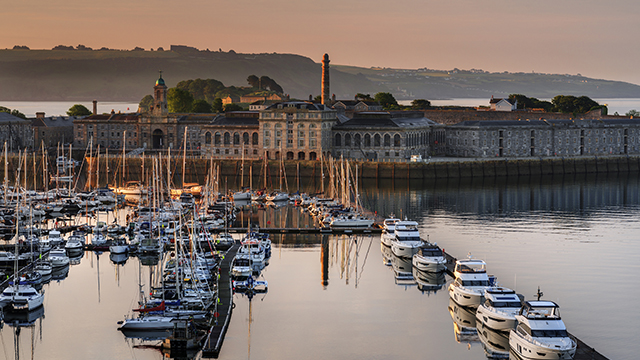Places for London’s chief executive on its ambitious plans for the capital
Transport for London’s commercial property arm, Places for London, is planning to form a student accommodation joint venture as part of an ambitious development drive.
Chief executive Graeme Craig told delegates at JLL’s Property Perspectives event earlier this week that the company also expects to “shortly” sign an east London-focused residential jv arrangement.
In a fireside chat with JLL UK and EMEA markets chief Stephanie Hyde, Craig said the company is seeking to replicate its housebuilding efforts in west London, where it has teamed up with Barratt to develop 4,000 homes.
Transport for London’s commercial property arm, Places for London, is planning to form a student accommodation joint venture as part of an ambitious development drive.
Chief executive Graeme Craig told delegates at JLL’s Property Perspectives event earlier this week that the company also expects to “shortly” sign an east London-focused residential jv arrangement.
In a fireside chat with JLL UK and EMEA markets chief Stephanie Hyde, Craig said the company is seeking to replicate its housebuilding efforts in west London, where it has teamed up with Barratt to develop 4,000 homes.
His comments came after it announced late last year that it would begin the search for a partner to develop 1,300 homes on the Limmo Peninsula near Canning Town station.
A tripartite agreement with partner Network Rail and an undisclosed London borough is also in progress, which aims to combine land interests from all parties and will involve land assembly. From there, the parties will “build new town centres in London” with commercial partners.
“That will be a whole new programme of work that runs alongside everything,” Craig told delegates.
Busy but quiet
The £2bn real estate company, formerly known as TTL Properties, was financially separated from TfL in 2022 to progress its pipeline without taking any funding from its transport operations. It has pledged to build 20,000 homes over the next decade.
The organisation has also set its sights on growing its income to £200m over the next six years, up from £85m, and more than doubling its asset value to £4.2bn by 2034. That plan factors in 50% affordable housing and a heavy focus on social value, Craig said.
“This next year will be the busiest year I’ve ever had,” he added. “It will also be the quietest year we will ever have in the future, and we will continue to grow.”
In its bid to meet its targets, the company is investing in generative AI tools to gain a fuller picture of the estate.
The organisation is also focusing on expanding its partnerships. It has formed seven joint ventures that are largely 50:50, with at least two more to follow. The eighth jv will focus on electric vehicle charging hubs, while the ninth will likely be purpose-built student accommodation, said Craig.
“We have sites that are ideally suited for students,” said Craig. He added that a logistics jv will “come along at some point in future”, although there are no plans in place at the moment.
“Now that we are confident we could do 20,000 homes, we can then start to plan ahead about what we can do with other sites.”
‘Partners that give a damn’
The company’s biggest residential developments are in Earls Court with Delancey, and Edgware with Ballymore, which have 7,500 homes between them, according to Craig.
In terms of asset classes, the pipeline is already diversifying. Last year Places for London signed a jv with Helical to develop 600,000 sq ft of offices above or close to London Underground stations. That will begin with a development at Bank’s Underground station later this year.
The company has also formed a build-to-rent joint venture with Grainger, which is on site with 1,240 homes and “hundreds, potentially thousands, more to come”.
Subject to a judicial review period expiring next week, Places for London will additionally proceed with redeveloping South Kensington Station in partnership with Native Land, with the development funding works for step-free access at the station. Partners on other projects include Notting Hill Genesis and Landsec.
When it comes to choosing partners, Craig said he is looking for people that “share our ambitions and values, not the people who offer us the most money”. “We’ve chosen very well to date,” he said. Craig added that its model allows for multiple partners to get involved with different aspects of its sites.
“As long as we’ve got people who focus on the long term, buy into everything that we are saying in terms of ESG, give a damn about this city, and are decent people,” he said.
Ford focus
When sharing his thoughts on how the industry can shape the future for cities, Craig compared his perspective of the city’s challenges with insight from US industrialist Henry Ford.
“It was Henry Ford who said ‘the future is here, it’s just unevenly distributed’,” said Craig. “We can point to the best of London, we just need to make the worst of London more like the best of London.”
Craig said there are “brilliant” people, schemes and initiatives in the industry, but also “some stuff” he is “not proud” to see. “We’ve got to get better at holding ourselves to account, at raising our standards and talking with one voice,” he said. “Probably 75% of my headspace is spent on politics, and in a year of election, I spend a lot of time thinking about… how to position ourselves and, increasingly, how we position ourselves as an industry.”
Craig also urged public sector owners of developable land, particularly around transport networks, to double down on their efforts with the commercial sector to help unlock land for homes and bring projects forward.
“Public sector bodies haven’t had the skills and the investment to make that happen,” said Craig. “We are where we are now with Places for London because we are determined to be able to take those opportunities forward. We have plans for making all of that happen for literally decades to come.”
Recounting the decision to incorporate Places for London as a wholly owned entity in 2014, Craig said: “If you own 5,500 acres of land in London, you are a property company, whether you accept it or not.”
A key issue underpinning the problems affecting many cities – including affordability and obsolescence – is a lack of understanding around the mutually beneficial relationship between housing development and transport, according to Craig.
He pointed to the ties between investment in infrastructure, development and housing, and the need to build homes to create the “ridership” – the number of passengers on a public transport system – to fund the investment. “Somehow you have to continue to make that case,” he said.
“The logic of this to me is completely inescapable. We just need to make sure we work better together as an industry, hold ourselves to account, and see that damn change happen across London, because the best of everything we need in the future is already there. We just need to address the rest.”
To send feedback, e-mail pui-guan.man@eg.co.uk or tweet @PuiGuanM or @EGPropertyNews
Photo © Transport for London











